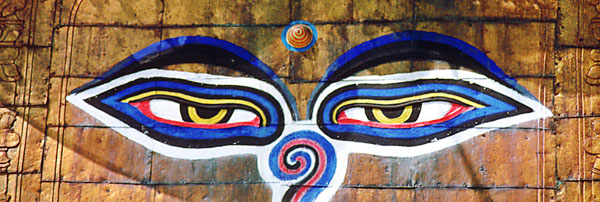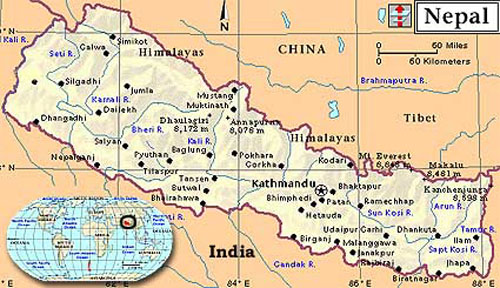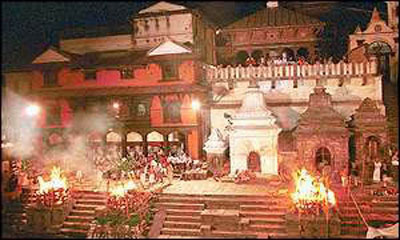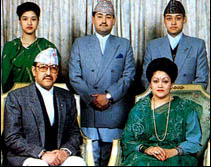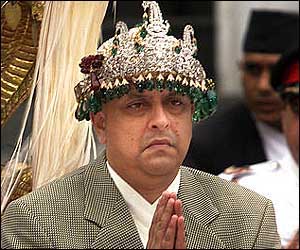|
The watchful eyes of Buddha -- temple
of Swayambhunath
Introduction
Majestic, Mystical, Magnificent ... Nepal is Shangri-La
Where else can you see the most spectacular mountains in the world, the
mixing of two great civilizations -- Chinese and Indian -- and a medieval
culture in modern times? And all this in one small country!
Rated number 1 of the countries I have visited.
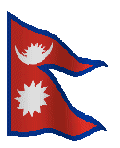
Statistics
Official Name:
Kingdom of Nepal
Capital:
Kathmandu
Government:
Constitutional Monarchy
Head of State:
King Gyanendra Bir Bikram Shah Dev (from June 4, 2001)
Population:
approx. 23 million
People:
Newari, Sherpas, Khas, Kirati, Magar, Tharu,Tamong and Tibetans
Area:
147,181 sq. km. (54,633 sq. mi.)
Highest Point:
Mount Everest (Chomo-Lungma - "Mother goddess of the Land")
29,035 ft or 8850 meters, highest mountain in the world
Time Zone:
5 hours 45 minutes ahead of GMT
Language:
Nepali (official), English
Religion:
90% Hinduism, 5% Buddhism, other minorities
Unit of Currency:
Rupee
Geology of Nepal
.
Around 200 million years ago (the Middle Permian Period) , an extensive
sea stretched along the latitudinal area now occupied by southern Asia.
This sea was named the Tethys. About this time, the super continent Pangea
began to gradually split into separate land masses and move apart in
different directions. The northern Eurasian land mass (called Angara) and
the southern Indian land mass (called Gondwana) started depositing large
amounts of sediments into the shallow sea. About seventy million years ago
(Upper Cretaceous Period) an initial mountain building process started
when the the Indian subcontinental plate moved north and collided with
Eurasia. As a result, the already shallow seabed rapidly folded and was
raised into longitudinal ridges and valleys. Soon afterwards, about 65
million years ago, (Upper Eocene Period), a second phase of mountain
building began when the bed of the Tethys started rising again. The sea
retreated and the seabed rose forming mountain ranges. After this,
periodic mountain building phases occurred as the Indian plate pushed
against the Eurasian plates which led to the ranges rising further. The
last major phase occurred 600,000 years ago. The result of all this plate
tectonic activity (that is still occurring) is the highest mountain range
in the world: the Himalayas -- a Sanskrit word meaning "the Abode of
Snow". The Kingdom of Nepal occupies the center of the Himalayas and has
nine of the world's fourteen highest peaks including Mt Everest (the
higest at 29,000 feet).
Nepal can be divided into three parallel bands running from the northeast
towards the southwest. Along the north runs the Great Himalayan Range,
which remains perpetually snow-covered. Some of the loftiest mountain
peaks in the world -- Mount Everest, Kanchenjunga, Lhotse, Makalu, Cho Oyu,
Dhaulagiri, Manaslu, and Annapurna lie within the northern region of
Nepal. Further south runs a complex system of intermediate mountains
(3,000-12,000 ft) and populated valleys. Prominent ranges in this mountain
system include the Mahabharat and Churia ranges. The third and
southernmost region is the Terai, a swampy terrain which is the northern
extension of the Indian plains.
Flora and Fauna
xThere are over 6000 species of trees, shrubs and wildflowers in Nepal.
The Rhododendrons is the national flower. Nepal also has a diverse
population of animals with 800 bird species and both common and exotic
mammals like deer, bears, jackals, monkeys and snow leopards. The Bengal
tiger, elephant, and rhinoceros are endemic to the southern Terai.
Attractions |
|
Kathmandu Valley
Kathmandu: Kathmandu (population 700,000) is Nepal's capital and largest
city It is situated at an altitude of 1,350m in the Kathmandu Valley. Its
historic center is Durbar Square with ancient temples, statues, and the
palace of Hanuman Dhoka. Kathmandu, home of the living goddess -- Kumari,
continues to preserve a rich cultural heritage light years away from other
non-nepalese cities of the same size. The Bagmati River forms its southern
boundary, while Thamel, the budget travellers' hangout extends to the
north. Bouddha is 6km east of downtown Kathmandu, surrounding the large
stupa of Bouddhanath.
Patan: Patan is located at the southern end of the Valley. The major
highlights of Patan are the Patan Durbar Square, Krishna Mandir, Royal
Bath, Kumbheshwor Temple, The Golden Temple, and many other ancient,
historic and artistic landmarks. It was one of the major architectural
creations of the Malla Dynasty.
Bhaktapur: Bhaktapur is located in the eastern end of the Valley, and is
about 12 kms away from Kathmandu. Points of interest are the Palace of 55
Windows, the Golden Gate, Nyatapola Temple, and Dattatreya Square.
Bhaktapur is also renowned for its intricate woodcarvings and preservation
of its ancient culture and history.
Dhulikhel: Dhulikhel is a small town about 30 km east of Kathmandu. From
here one can get a panaromic view of the Himalayas from east to west.
Nagarkot: Nagarkot is located at about 32 km east of Kathmandu and is a
hillstation. It is noted for its spectacular sunrise, offering views of
the Mt. Everest and other mountains in the distant east.
Pokhara
The Pokhara Valley is one of the most picturesque spots of Nepal. The
beauty of the valley is enhanced by its lakes -- Phewa, Begnas, and Rupa,
which have their source in the glacial region the Annapurna Range of the
Himalayas. Pokhara Valley is situated at an altitude of 827 meters above
sea-level. Day walks can be taken to Sarangkot (1592m), the limestone
caves at Mahendra Gufa or Rupa and Begnas Tals lakes. More exertion will
be required to tackle the three to four-day Annapurna Skyline Trek.
History of Nepal
The history of Nepal can be divided into the following dynasties:
Ahirs and Gopalas: The early history of Nepal is poorly understood. The Ahirs are thought to be the early cattle-tending people of Lord Krishna.
There were also several successive waves of Tibeto-Burman migrants.
Kirats (circa 800 B.C. - 300 A.D.): Over 25 outstanding kings in the
reigned during this early period. Buddha was born in Lumbini (southern
Nepal) in about 563 B.C. The last Kirat king -- Kirati Gastee, succumbed
to a
Licchavi invasion from India in about 300 A.D.
Licchavis (circa 400 - 600 A.D.): They were Indian invaders who brought
with them the first golden age of Nepalese arts. They brought Hinduism and
the caste system to Nepal.
Thakuris: (circa 600 - 1100 A.D.): After 600 A.D. the Thakuris took over.
This was a grim period of instability, often referred to as the "Dark
Ages". In the 10th century King Gunakamadeva founded Kantipur, today's
Kathmandu. Several centuries later (1100 A.D.) the Thakuri king, Arideva,
founded the Malla dynasty that started a renaissance of Nepali culture.
Mallas (circa 1100 - 1768): This period was a stable age of peace and
prosperity when great works of art, statues and temples were created. It
is considered to be the golden age of Nepal.
Shah (1768 - 1846): In 1768, King Prithivi Narayan Shah of Gorkha unified
the country after defeating the Malla kings in the Valley. At this time,
all of what is now Nepal was divided into small principalities. In 1816,
after a war with the British, Nepal adopted a policy of seclusion from
foreign contacts.
Ranas (1846 - 1950): These (hereditary) prime ministers usurped the ruling
power from the Shah kings in 1846 A.D. but still accepted the king as
sovereign. They ruled the country for the next 104 years.
Shahs (1950 - present): The popular revolution of November 1950 started by
King Tribhuvan brought the Shah kings back to power. After the fall of
the Rana regime in February 1951, Nepal saw the dawn of democracy.
The parliamentary government under the multi-party system was adopted
for some years. In 1960, King Mahendra abolished the multi-party system,
replacong it with the partyless Panchyat system. However, the popular
democratic revolt of 1990 reinstated the multi-party democratic system and
a new democratic constitution was adoptedon November 9, 1990. King
Birendra Bir Bikram Shah Dev (descendant of King Prithivi Narayan Shah and
10th king in dynasty) lost much of his power, but was still revered by the
people. On June 1, 2001 the 55-year-old King Birendra Shah Dev, Queen
Aishwarya, the king and queen's other two children - Prince Nirajan and
Princess Sruti, three of the king's sisters (Jayanti, Sharada and Shanti)
and brother-in-law Kumar Khadga were murdered (automatic rifle gunfire) by
Crown Prince Dipendra. Dipendra who shot himself in the head was named
king but remained in a coma until his death two days later. The late King
Birendra's younger brother -- Gyanendra Shah Dev -- was then named King on
June 4, 2001. |
